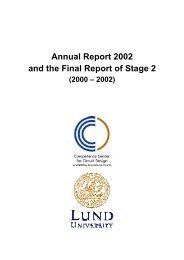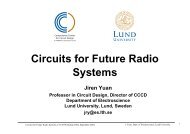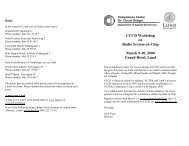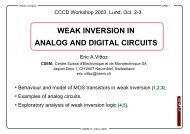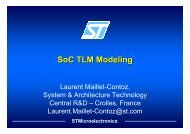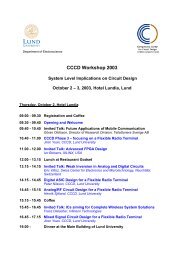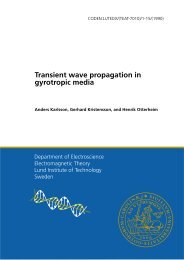Design of Antennas for Handheld DVB-H ... - Lunds tekniska högskola
Design of Antennas for Handheld DVB-H ... - Lunds tekniska högskola
Design of Antennas for Handheld DVB-H ... - Lunds tekniska högskola
You also want an ePaper? Increase the reach of your titles
YUMPU automatically turns print PDFs into web optimized ePapers that Google loves.
7 Conclusion<br />
During this project the different measurements have been the major problem, and<br />
already during our first measurement we ran into trouble. No <strong>DVB</strong>-T signal was<br />
detected when measurements with the spectrum analyzer was done. The reason<br />
<strong>for</strong> this is that the walls and windows attenuate the signal. The windows at Perlos<br />
laboratory have a thin metal layer on the glass.<br />
This means that there is no indoor coverage in Perlos laboratory in Lund and<br />
probably not in larger parts <strong>of</strong> Skåne. For the <strong>DVB</strong>-H system to be successful<br />
coverage inside cars, busses, trains and buildings has to be achieved. The base<br />
stations operating today only provide full indoor coverage in the near <strong>of</strong> the base<br />
stations. If the <strong>DVB</strong>-H system is successful more base stations are planed and full<br />
indoor coverage will be achieved.<br />
As you all now by now the frequencies used <strong>for</strong> the <strong>DVB</strong>-H system are 470-862<br />
MHz. This frequency range is good in aspect <strong>of</strong> getting good coverage with few<br />
base stations. The only drawback with these low frequencies is that the antennas<br />
become electrically very small, and thereby inefficient. If higher frequencies had<br />
been used more base stations had been required since higher frequencies have a<br />
higher propagation loss.<br />
<strong>DVB</strong>-H system can use all existing <strong>DVB</strong>-T base stations and only a handful new<br />
base stations have to be built in the future. This is a huge economical advantage<br />
against competing systems. Another big advantage is that it is a broadcasting<br />
system, which means that it is spectrum efficient. That it is a broadcasting system<br />
means that an infinite number <strong>of</strong> users can watch the same show without<br />
occupying more bandwidth. This could be compared to the technique used today<br />
in the 3G network where smaller shows are streamed to each user separately.<br />
One <strong>of</strong> the reasons why shows are streamed separately is that in this way the<br />
operators can easily control how long time each user has watched and thereby be<br />
charged. Another reason is that the operators have a lot <strong>of</strong> unused capacity in the<br />
3G network and want to use this to stream TV shows in.<br />
A big difference between <strong>DVB</strong>-H and <strong>DVB</strong>-T is time slicing. This has been added<br />
in the <strong>DVB</strong>-H standard to decrease the power consumption to a level suitable <strong>for</strong><br />
handheld devices. This technique has a couple <strong>of</strong> drawbacks. The first one is that<br />
when the user likes to change channel it might take up to five seconds be<strong>for</strong>e the<br />
next burst are transmitted. This means that no picture can be shown until the burst<br />
<strong>for</strong> the chosen channel has been received. The second one is if the terminal has<br />
bad reception during the burst time, then the terminal will not have any video to<br />
play until the next burst is received. When this technique is used live shows will<br />
74



